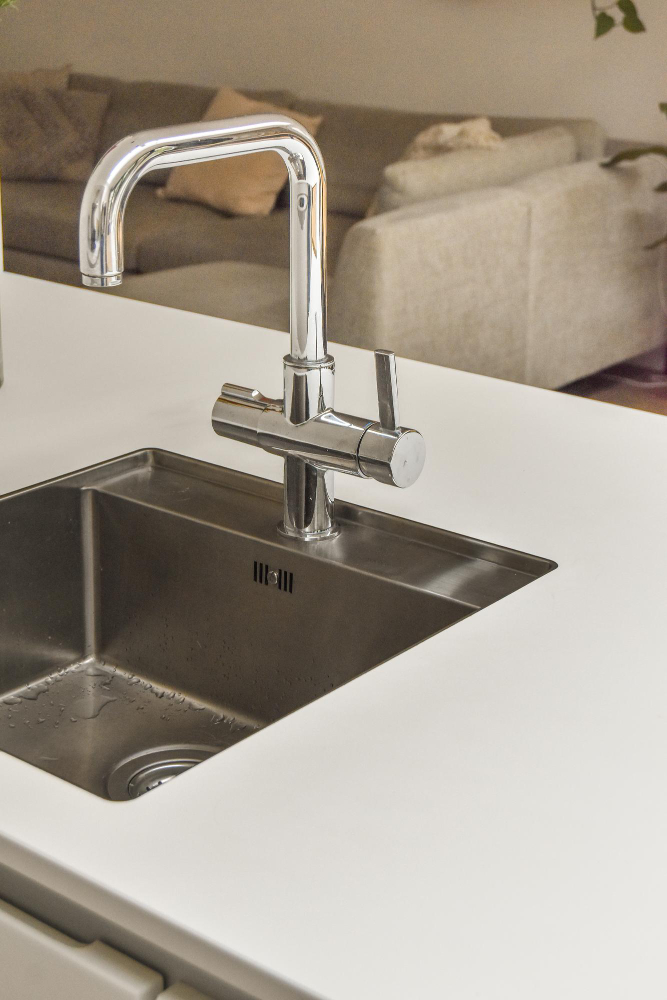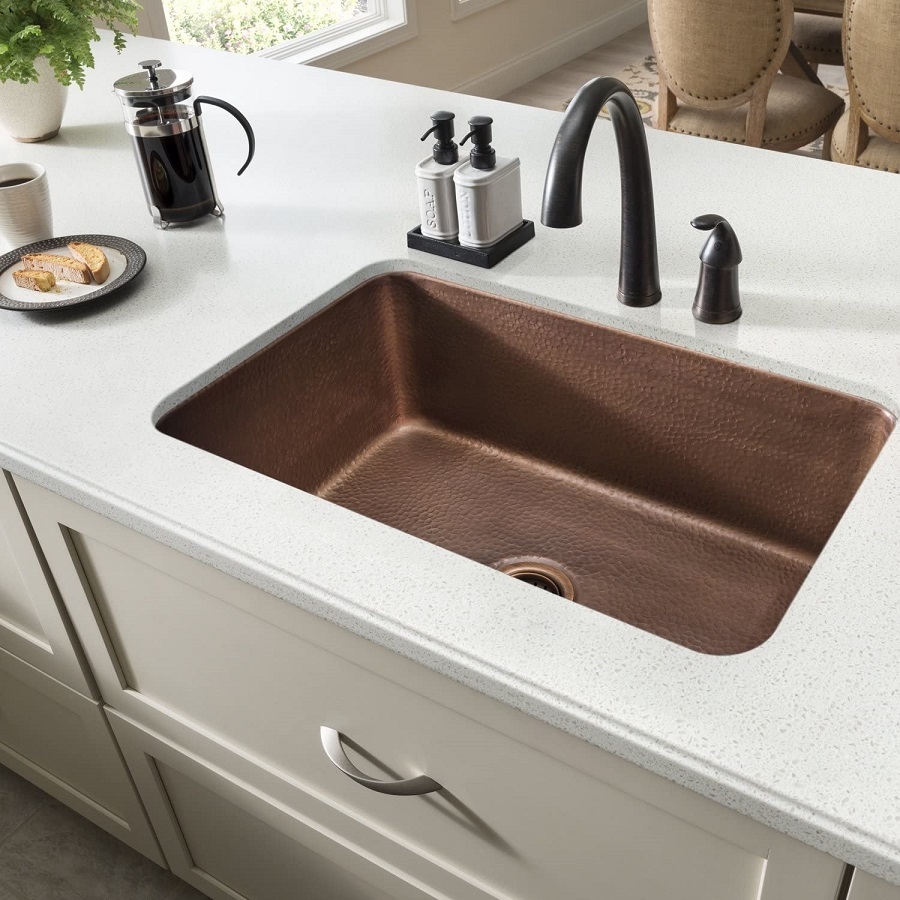Last updated on
Let’s compare and contrast undermount and top-mount sinks to help you choose the right one for your kitchen.
As a seasoned home decorator, I have seen my fair share of kitchen renovations. And one of the most common questions I get asked is, “Should I go for an undermount or top-mount sink?” It’s a question that may seem trivial at first, but it can make all the difference in the look and functionality of your kitchen.
So let me take you on a journey through my experiences with these two types of sinks and help you decide which one is right for your home.
Key takeaways:
- Undermount sinks offer a seamless and sleek look.
- Top-mount sinks are more budget-friendly and easier to install.
- Undermount sinks are easier to clean and more hygienic.
- Top-mount sinks have more design options and add character to the kitchen.
- Undermount sinks are more durable, while top-mount sinks are more affordable.
What's Inside
Undermount Sink Overview

Undermount sinks are becoming increasingly popular in modern kitchen designs. Unlike top-mount sinks, undermounts are installed underneath the countertop, creating a seamless look that is both sleek and functional.
As someone who has seen many kitchens with undermount sinks, I can attest to their beauty and practicality.
One of the main benefits of an undermount sink is its ease of cleaning. With no lip or rim around the edge, crumbs and debris can be easily swept into the sink without getting caught on any edges or crevices. This makes for a more hygienic kitchen environment overall.
Another advantage of an undermount sink is its versatility in terms of design options. Because it sits flush with your countertop surface rather than being dropped into it like a top-mount sink would be, you have more freedom to choose different materials for your countertops without worrying about compatibility issues.
If you’re looking for a clean and modern aesthetic in your kitchen design while also prioritizing functionality and ease-of-use when it comes to cleaning up after meals – then an undermounted sink might just be perfect!
Top-Mount Sink Overview

Top-mount sinks, also known as drop-in or self-rimming sinks, are the most common type of sink found in homes. They are called top-mount because they sit on top of the countertop with their rim overlapping it.
Top-mount sinks come in a variety of materials such as stainless steel, porcelain, and cast iron.
In my experience working with clients who prefer top-mount sinks over undermounts is that they tend to be more budget-friendly and easier to install. The installation process for a top-mounted sink involves cutting a hole into your countertop surface that matches the size and shape of your chosen sink’s dimensions.
One advantage I have noticed about this type of sink is its versatility when it comes to replacing an old one or upgrading from another style since you don’t need any special tools or skills for installation.
However, one downside I’ve seen with these types of sinks is that food particles can get trapped between the lip edge where it meets the counter making cleaning up after meals more challenging than other styles like undermounts which have no edges exposed above counter level.
Installation Process Comparison

Tthere are some notable differences between undermount and top-mount sinks. Installing a top-mount sink is relatively straightforward; you place the sink into a pre-cut hole in your countertop and secure it with clips or screws.
On the other hand, installing an undermount sink requires more work as it needs to be mounted underneath your countertop using special brackets.
I remember one time when I was helping my friend renovate her kitchen, she had already purchased a beautiful porcelain undermount sink but didn’t realize that its installation would require additional labor costs due to its unique mounting requirements. In contrast, another client of mine opted for a top-mount stainless steel option because they wanted something easy-to-install without compromising on style.
Ultimately, whether you choose an undermount or top-mount sink will depend on various factors such as budget constraints and personal preferences regarding aesthetics and functionality.
Aesthetics and Design

Top-mount sinks are often seen as the more traditional option, with a visible rim that sits on top of the countertop.
They come in a variety of materials such as stainless steel, porcelain or cast iron which can add character to your kitchen.
On the other hand, undermount sinks offer a sleeker look by being mounted underneath the countertop. This creates an uninterrupted flow from counter to sink which is perfect for modern kitchens with clean lines.
When choosing between these two options consider your overall kitchen style and what you want your sink area to look like. If you’re going for a classic or rustic feel then perhaps go for a top-mount sink but if you prefer contemporary designs then an undermount may be more suitable.
Ultimately it’s important that whatever choice you make fits seamlessly into your existing decor so take some time before making any decisions!
Cleaning and Maintenance

Top-mount sinks are easier to clean since they sit on top of the countertop, making them more accessible for wiping down spills or crumbs. However, the lip around the sink can collect dirt over time if not cleaned properly.
On the other hand, undermount sinks offer a sleeker look with no visible rim or edge that can trap debris. But because they’re installed underneath the countertop, cleaning requires reaching into tight spaces which may be difficult for some homeowners.
In terms of maintenance, both types require regular upkeep to prevent stains or scratches from forming on their surfaces. Undermounts tend to be more susceptible to water damage if not sealed correctly during installation while top-mounts may develop rust around its edges over time.
Ultimately when deciding between an undermount vs a top-mount sink in your kitchen renovation project consider how much effort you’re willing put into maintaining it as well as your personal preferences in style and design
Durability and Longevity

In my experience, undermount sinks tend to be more durable because they are installed underneath the countertop, which provides extra support for the sink’s weight.
This also means that there is less chance of water damage or mold growth around the edges of the sink.
On the other hand, top-mount sinks can be just as durable if they are made from high-quality materials such as stainless steel or cast iron. However, over time these types of sinks may develop rust spots or scratches on their surfaces due to exposure to water and cleaning products.
Ultimately, when choosing between an undermount or top-mount sink based on durability and longevity factors alone may not make a significant difference in your decision-making process since both types can last for many years with proper care.
Cost Differences

Top-mount sinks are generally less expensive than undermount sinks. This is because the installation process for a top-mount sink is simpler and requires less labor and materials.
On the other hand, undermount sinks require more work to install as they need to be mounted underneath the countertop.
However, it’s important not just to consider upfront costs but also long-term expenses. Undermount sinks tend to have a longer lifespan than top-mounts due in part because of their seamless design that prevents water from seeping into crevices where bacteria can grow over time.
Ultimately, your decision on which type of sink you choose should depend on your budget and priorities for your kitchen renovation project. If you’re looking for an affordable option with easy installation but don’t mind sacrificing some durability or aesthetics, then a top-mount sink may be right up your alley.
However if longevity and sleek design are important factors in making this decision then investing in an undermount sink might make more sense even though it will come at a higher price point initially




